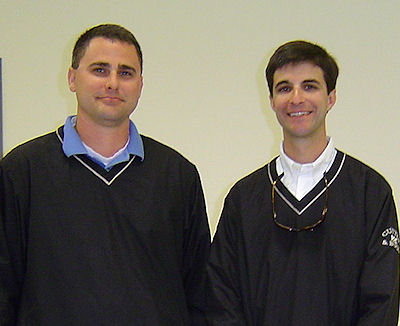
Tim Hobbs (R) of Baldwin EMC discussed strategies for achieving energy conservation and lower utility bills at the March meeting of Silverhill's "Men's 710." Greg Gips (L) assisted Hobbs in the presentation with a variety of educational materials.
Air Leaks. Heating and cooling costs can be reduced by about a third just by finding and fixing air leaks. Gaps along a home’s foundation, around its doors, and surrounding its windows, can be sealed readily. Even holes around plumbing entering and exiting the home are potential air pathways that can be eliminated with caulking. Fireplaces in our Baldwin County area may not always have dampers, but even fireplaces with dampers need to be closed when not in use to minimize loss of heated or cooled air through the chimney. No damper? The home owner needs to find a way to close off the gap.
Insulation. Fifteen inches of insulation in the attic will give an R value of 30 to 38. R values for walls and for floors (for houses on piers) should be 13 and 19, respectively. Attic hatches are often overlooked, and insulation needs to be installed over them. Basically, insulating to a higher R value may not be cost-effective.
Air Conditioners and Heat Pumps. Air filters are key to minimizing utility bills. Consider changing those filters every time you get a utility bill. The units themselves should be serviced regularly. Thermostat settings of 68 degrees in the winter and 78 degrees in the summer are optimum settings for comfort, but moving the thermostat down a bit in winter and up a bit in summer will save the home owner about 3% per degree change in utility costs. Of course, a programmable thermostat can help even more by automatically setting the operation level of the air conditioner or heat pump lower in winter and higher in summer at times when the home is not occupied. Such a programmable thermostat is more cost effective than leaving the heating and cooling system to run at some constant setting.
Conserving Energy in “Real Cold” Weather. Heat pumps have an emergency heat setting. When the temperature gets below the low 20s, emergency heat will be triggered in the heat rods within the heat pump’s heat exchanger. The result will be high energy use and high cost. What many people do not recognize is that those same high energy rods are triggered if you adjust your thermostat more than a couple degrees up to heat up a place temporarily. To minimize triggering that automatic feature, the thermostat adjustment for heat needs to be adjusted a degree or two at a time in steps, rather than moving to an immediate high heat call from that thermostat.
Water Heaters. The second biggest energy user in the typical home is the water heater. To maximize energy savings and still have reasonably useful warm water, a setting of 120 degrees would be a wise setting.
Appliances and Lighting. Air transmission of heated or cooled air is the culprit for stealing energy efficiency. Poor seals on clothes driers or refrigerators can be repaired. In the case of poor heat transmission because of dusty coils on the refrigerator, a brush or vacuum may be an energy conserver. In terms of lighting costs, conversion to CFC bulbs where feasible will lower energy consumption. Shutting off computers and TVs when not in use are another way to make more pocket change.
Eyeballing Problems. A home owner can daily monitor his or her electric meter for a couple weeks and identify when energy use is high. When elevated energy use occurs with the use of specific devices in the home, the home owner will have a way of focusing on reducing expenses.
Professional Energy Audits. Tim Hobbs is a community and home resource with lots of ideas. He is available for specific questions AND answers at (251) 989-6247.





